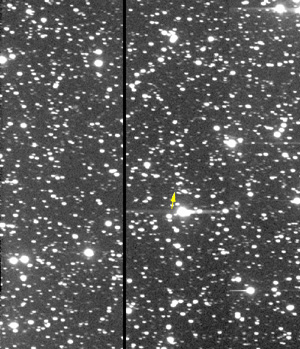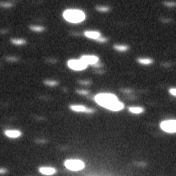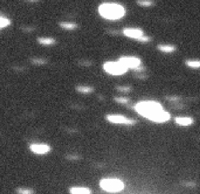|
Leonid MAC |
| home |
| View the shower |
| Mission Brief |
| Science Update |
| Media Brief |
| links |
LEONID DAILY NEWS: December 30, 2003
FIGURE: Minor planet 2003 EH_1, as it is observed to move among the stars of the Southern Triangle with the ESO/New Technology Telescope on December 24, 2003. The left image is a 5 minute R-band exposure, showing the full EMMI CCD frame. The minor planet is about magnitude 23. The field of view is 8 x 10 arcminutes. An arrow points at 2003 EH_1 (Photo: E. Jehin, P. Jenniskens ESO/NTT) - Click on the image for enlargement.
The animation above shows three R and one V-band exposure, which show the object move among the stars. The field of view is 1 x 1 arcminute .
Emmanuel Jehin, Malvina Billeres, and Peter Jenniskens have succeeded in detecting
2003 EH_1 at the ESO/New Technology Telescope on Christmas Eve, December 24.
The observation was complicated by the extreme faintness of the distant minor planet,
about magnitude 23 at the time, and its inconvenient location that permitted observations
only at a low elevation just before dawn. 2003 EH_1 was 3.108 AU from the Sun and
3.726 AU from Earth when it was detected amid a string of stars in the southern milky
way, in the constellation of the Southern Triangle.
The recent discovery of the Quadrantid parent and the quest to find the moment when our biggest shower was created.
"This new observation will help improve the orbit of 2003 EH_1 by about a factor of 100 and perhaps prove that an ancient comet, C/1490 Y1, was in fact 2003 EH_1 at the time when it created the Quadrantid shower",
explains Emmanu’żl Jehin of the European Southern Observatory. 2003 EH_1 was tracked
for only 48 days following its first sighting by the Lowell Observatory Near-Earth Object Search
on 2003 March 06, and had not been seen since May.
The observation follows on a discovery by team member Dr. Peter Jenniskens, a meteor
astronomer with the SETI Institute at NASA Ames Research Center. In early December,
Jenniskens had identified minor planet 2003 EH_1 as the parent of the yearly Quadrantid
shower. 2003 EH_1 moves among the meteoroids that give rise to this spectacular meteor
shower. This is the most active annual shower, with peak rates of Zenith Hourly Rate
= 130 per hour. The Quadrantids are also the only major shower that did not have a
parent until now. The identification was announced on a
telegram issued by the International
Astronomical Union on December 08, and is described in a paper submitted to the
Astronomical Journal.
This discovery confirmed that the comet was not lost from the stream as was generally assumed because of the stream's rapid evolution on account of Jupiter. Jenniskens had found a few years earlier that the Quadrantids are a very young shower, no older than about 500 years, and expected the parent body to be still among the meteoroid stream. "If not, the shower should have been more dispersed than observed in precise photographic measurements of Quadrantid meteoroid orbits", according to Jenniskens, "with Jupiter frequently approaching the stream at its farthest point from the Sun".
The young age stands in contrast to the large mass of the stream of dust, a total of 10 trillion (10,000,000,000,000) kg. This only squares with the young age if the comet broke up, during which much more mass is released than in the more normal comet ejection process. 2003 EH_1 is thought to be a remaining fragment of this event, that occurred some 500 years ago, with other fragments perhaps still to be found.
About 500 years ago, in the winter of 1490/1491, a comet named "C/1490 Y1" was seen by Chinese, Japanese and Korean astronomers. In 1979, Dr. Ichiro Hasegawa calculated an orbit based on these accounts and pointed out that the comet moved in the same orbital plane as that of the Quadrantid meteor shower. The comet has not been seen since or prior to that event. If C/1490 Y1 is a short-period comet, then It is possible that the comet broke apart half an orbit earlier, making it visible to the early astronomers. If so, the Quadrantids were created in that event.
However, Jenniskens found it difficult to match the current known orbit of 2003 EH_1 with the perihelion time of C/1490 Y1. Small uncertainties in the orbit of 2003 EH_1 cause a big uncertainty in the orbit when integrated back to 1490. The reason for that is that there were many close encounters with Jupiter in the past 500 years. Brian Marsden, director of the IAU Minor Planet Center, further investigated the issue and concluded that more recent observations of 2003 EH_1 were needed to refine its orbit.
"ESO was particularly well suited to try and observe the object," says Jehin. The recovery of 2003 EH_1 on Christmas Eve is expected to help trace back the comet's path.
The new images
The European Southern Observatory was uniquely located for this observation, because of the southern declination of the object's position. The powerful New Technology Telescope needed only brief 5 minute exposures, following the minor planet on its orbit through the solar system, to detect it among the stars. The stars are slightly elongated due to the minor body's motion. The ESO/NTT observations were obtained with the EMMI imager through red (R-band) and visual (V-band) filters. Three exposures of 5 minutes each were made in the R-band, and 3 exposures of 5 minutes each in the V-band. The comet was detected in five of the exposures, and lost in morning twilight in the sixth exposure.
FIGURES: Details of Figure 1, measuring a field of view of 2' x 2' and 1' x 1', respectively. East is to the right, north is at the bottom. The sky was clear during the observations and the seeing 0.8", measured on the star trails. (Photo: E. Jehin, P. Jenniskens ESO/NTT)
2003: Dec 30 - Quadrantid parent comet observed Dec 28 - Good Quadrantid show on 2004 Jan 04 Dec 08 - Quadrantid parent discovered 2002: Nov 23 - "Shock" confirmed Nov 22 - New molecular band detected Nov 21 - Leonids tracked Nov 20 - Asteroids named after Leonid MAC participants Nov 19 - Leonid storms rich in faint meteors Oct 22 - Collecting meteoroid debris from snow cover Oct 21 - Highlights COSPAR/World Space Congress Aug 31 - First UV spectrum: Leonid from space 2001: Dec 11 - Shocking Leonid Dec 01 - Moon impacts Nov 26 - Near-IR persistent train emission Nov 24 - Results of near-real time flux measurements Nov 22 - Wowh! Optical meteor spectra 2000: Dec. 25 - Ursid shower circular IMO Dec. 24 - Ursid shows early release of sodium Dec. 23 - Ursid outburst confirmed Dec. 18 - Dec 22 Ursid outburst Nov. 20 - A bacterial fingerprint? Nov. 15 - HCN disappears mysteriously Nov. 14 - Meteor shower from space Nov. 13 - Organic fingerprint Nov. 12 - Train airglow chemistry Nov. 11 - Hard bits and persisting glows Nov. 10 - Meteoroid debris detected Nov. 09 - New meteor picture Nov. 08 - Spin city Nov. 07 - Meteors affect atmospheric chemistry Nov. 06 - Listen to this! Nov. 04 - Fear of heights? Nov. 03 - The pale (infra-red) dot Nov. 02 - Twin showers Nov. 01 - Leonids approaching Earth Oct. 31 - Prospects for Moon Impact Studies Oct. 30 - Comet dust crumbled less fine Today's news
| ||





